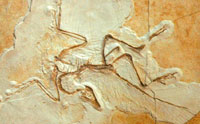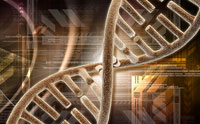Three researchers wanted to test what would happen to future generations of the purple sea urchin if exposed to more acidic sea water. How did the small, spiny sea creatures respond to the challenge? More… …read more Read more here: icr.org
Throughout North and South America lives one of God’s most amazing creatures, the hummingbird. I like to call it ‘God’s tiny miracle’. There are more than 300 species of this beautiful minute bird, with its iridescent plumage. Hummingbirds range in size from the tiny bee hummingbird, which is only about the length of an adult’s little finger, to the giant hummingbird, which may reach 22 centimetres (8.5 inches)—the width of a magazine page. There are nine species in North America. Read More The Hummingbird: God’s Tiny Miracle – Answers in Genesis.
Refuting the evolutionary ‘sea-water’ argument. …read more Read more here: creation.com
But organic molecules like pigments, and especially proteins, shouldn't be there if the specimen is older than a million years. These results challenge the “millions of years” date assigned to this fossil. More… …read more Read more here: icr.org
Microbiology and parasitology research based on the creation paradigm appears to provide some answers to these puzzling questions regarding the Plasmodium “kind” (Family Haemosporidae). …read more Read more here: AIG Daily
An ounce of primate prompts a pound of speculation. …read more Read more here: AIG Daily
As scientists begin to unravel the complexity of the genome, they are discovering that pseudogenes are not so “pseudo” after all. More… …read more Read more here: icr.org
For any fruitful debate to proceed regarding the plausibility of evolution, the right questions first need to be asked. …read more Read more here: creation.com
Eunotosaurus already had the organization of leg and breathing muscles unique to turtles, inferred by muscle attachment points seen on its fossilized bones. More… …read more Read more here: icr.org
Are human embryos created through cloning less human than those produced through the union of sperm and egg? …read more Read more here: AIG Daily
Results from a recent study in human and chimpanzee genetics have shipwrecked yet another Darwinian hypothesis. More… …read more Read more here: icr.org
The human cloning method of Shoukhrat Mitalipov’s group at the Oregon Health & Science University isn’t ready to churn out walking, talking clones, but researchers believe it will churn out embryonic stem cells. …read more Read more here: AIG Daily
A biomechanical study of murre—one that dives well but also flies—presumably sheds light on penguin flightlessness. …read more Read more here: AIG Daily
Are native-like protein folds easy to generate naturally from reused secondary structures? …read more Read more here: creation.com
The Human Genome Project—according to the interpretations of evolutionists—scientifically disproved the possibility of all humans being descended from one man and one woman. But what does the science really demonstrate? …read more Read more here: AIG Daily
Claims that the eye-brain nerve connections are incredibly improbable fail to see the proper source of wonder: the brain’s incredible ability to learn to see. …read more Read more here: creation.com
New “fresh flesh and blood” mammoth discovery animates clonal hopes. …read more Read more here: AIG Daily
The declining reaction times and diminishing IQ data are consistent with what the authors called “dysgenic trends”—downward-trending intelligence genes. More… …read more Read more here: icr.org
Are native-like protein folds easy to generate naturally? …read more Read more here: creation.com
Mankind was not the first to invent glass. Since creation, untold trillions of little creatures, called diatoms, have made their homes out of glass. …read more Read more here: AIG Daily
How do squid match their surroundings when they are colourblind? The solution has inspired designers of a camouflaging material. …read more Read more here: creation.com
Entomologists regularly discover examples of mathematical genius hardwired into various tiny-brained arthropods. More… Read more here: icr.org
Multicellular organisms’ genomes typically contain a great deal of non-coding DNA (often called “junk” DNA, implying that it has little function), but not the bladderwort. Read more here: AIG Daily
Does this prove molecules-to-man evolution? Read more here: creation.com
“As we excavated the fossil, I thought that we were looking at a skin impression. Then I noticed a piece came off and I realized this is not ordinary—this is real skin.” More… Read more here: icr.org
Recently reported research describes massively long and complex gene tails that do not code for proteins, but instead contain hundreds to thousands of built in regulatory switches per gene RNA copy. More… Read more here: icr.org
The archer fish’s ability to snare its prey is no hit-or-miss affair. Read more here: creation.com











































